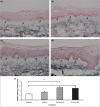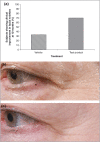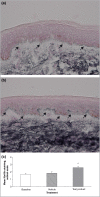Effects of a cosmetic 'anti-ageing' product improves photoaged skin [corrected]
- PMID: 19438432
- PMCID: PMC2774146
- DOI: 10.1111/j.1365-2133.2009.09216.x
Effects of a cosmetic 'anti-ageing' product improves photoaged skin [corrected]
Abstract
Background: Very few over-the-counter cosmetic 'anti-ageing' products have been subjected to a rigorous double-blind, vehicle-controlled trial of efficacy. Previously we have shown that application of a cosmetic 'anti-ageing' product to photoaged skin under occlusion for 12 days can stimulate the deposition of fibrillin-1. This observation infers potential to repair and perhaps clinically improve photoaged skin.
Objective: We examined another similar over-the-counter cosmetic 'anti-ageing' product using both the patch test assay and a 6-month double-blind, randomized controlled trial (RCT), with a further 6-month open phase to assess clinical efficacy in photoaged skin.
Methods: For the patch test, commercially [corrected] available test product and its vehicle were applied occluded for 12-days to photoaged forearm skin (n = 10) prior to biopsy and immunohistochemical assessment of fibrillin-1; all-transretinoic acid (RA) [corrected] was used as a positive control. Sixty photoaged subjects were recruited to the RCT (test product, n = 30 vs. vehicle, n = 30; once daily for 6-months; face & hands) [corrected] with clinical assessments performed at recruitment and following 1-, 3- & 6-months of use [corrected]. Twenty-eight subjects had skin biopsies (dorsal wrist) at baseline and at 6 months of treatment for immunohistochemical assessment of fibrillin-1 (test product, n = 15; vehicle, n = 13). All subjects [corrected] received test product for a further 6-months. Final clinical assessments were performed at the end of this open period; 27 subjects received test product for 12-months [corrected].
Results: In the 12-day patch test assay, we observed significant immunohistological deposition of fibrillin-1 in skin treated by test product and RA as compared to untreated baseline (P = 0.005 and 0.015 respectively). In the clinical RCT, at 6 months, compared to baseline assessment, 43% of subjects on test product had an improvement in facial wrinkles (P = 0.013), whereas only 22% of subjects using vehicle had clinical improvement (P = ns). Between group comparison of test product and vehicle was non-significant (P = 0.10). After 12 months, there was a significant benefit of test product over that projected for vehicle (70% vs. 33% of subjects improving; combined Wilcoxon rank tests, P = 0.026). There was significant deposition of fibrillin-1 in skin treated for 6 months with test product (mean +/- SE; vehicle, 1.84 +/- 0.23; test product, 2.57 +/- 0.19; P = 0.019).
Conclusion: An over-the-counter cosmetic 'anti-ageing' product demonstrated clear benefit over vehicle in fibrillin-1 deposition over a 6-month trial period. There was a corresponding but non-significant trend towards clinical improvement in facial wrinkles. Clinical improvements in the treated group were increased after a further 6-months of use. This study demonstrates that a cosmetic may improve the appearance of wrinkles and further supports the use of fibrillin-1 as a robust biomarker for repair of photoaged dermis.
Figures



Comment in
-
Evidence for an 'anti-ageing' product may not be so clear as it appears.Br J Dermatol. 2009 Nov;161(5):1207-8; author reply 1208-9. doi: 10.1111/j.1365-2133.2009.09433.x. Epub 2009 Aug 12. Br J Dermatol. 2009. PMID: 19678818 No abstract available.
-
Effects vs improvement of photoaged skin.Arch Dermatol. 2010 May;146(5):546-9; discussion 549-50. doi: 10.1001/archdermatol.2010.62. Arch Dermatol. 2010. PMID: 20479305 No abstract available.
Similar articles
-
Repair of photoaged dermal matrix by topical application of a cosmetic 'antiageing' product.Br J Dermatol. 2008 Mar;158(3):472-7. doi: 10.1111/j.1365-2133.2007.08364.x. Epub 2007 Dec 6. Br J Dermatol. 2008. PMID: 18070204 Clinical Trial.
-
A short-term screening protocol, using fibrillin-1 as a reporter molecule, for photoaging repair agents.J Invest Dermatol. 2001 May;116(5):672-8. doi: 10.1046/j.1523-1747.2001.01322.x. J Invest Dermatol. 2001. PMID: 11348454 Clinical Trial.
-
Fibrillin-rich microfibrils are reduced in photoaged skin. Distribution at the dermal-epidermal junction.J Invest Dermatol. 1999 May;112(5):782-7. doi: 10.1046/j.1523-1747.1999.00562.x. J Invest Dermatol. 1999. PMID: 10233772
-
Over-the-counter anti-ageing topical agents and their ability to protect and repair photoaged skin.Maturitas. 2015 Mar;80(3):265-72. doi: 10.1016/j.maturitas.2014.12.019. Epub 2015 Jan 10. Maturitas. 2015. PMID: 25616779 Review.
-
Treatment of photoaged skin with topical tretinoin.Skin Pharmacol. 1993;6 Suppl 1:78-82. doi: 10.1159/000211167. Skin Pharmacol. 1993. PMID: 8142115 Review.
Cited by
-
Comparisons against baseline within randomised groups are often used and can be highly misleading.Trials. 2011 Dec 22;12:264. doi: 10.1186/1745-6215-12-264. Trials. 2011. PMID: 22192231 Free PMC article.
-
Multifaceted amelioration of cutaneous photoageing by (0.3%) retinol.Int J Cosmet Sci. 2022 Dec;44(6):625-635. doi: 10.1111/ics.12799. Epub 2022 Sep 6. Int J Cosmet Sci. 2022. PMID: 35778881 Free PMC article.
-
Marine Fungus Aspergillus chevalieri TM2-S6 Extract Protects Skin Fibroblasts from Oxidative Stress.Mar Drugs. 2020 Sep 8;18(9):460. doi: 10.3390/md18090460. Mar Drugs. 2020. PMID: 32911774 Free PMC article.
-
The pleiotropic effects of Prunus avium L. extract against oxidative stress on human fibroblasts. An in vitro approach.Mol Biol Rep. 2021 May;48(5):4441-4448. doi: 10.1007/s11033-021-06464-0. Epub 2021 Jun 7. Mol Biol Rep. 2021. PMID: 34100152
-
How to fight acute sun damage? Current skin care strategies.Photochem Photobiol Sci. 2024 Oct;23(10):1915-1930. doi: 10.1007/s43630-024-00641-3. Epub 2024 Sep 28. Photochem Photobiol Sci. 2024. PMID: 39342016
References
-
- Lavker RM, Zheng PS, Dong G. Aged skin: a study by light, transmission electron, and scanning electron microscopy. J Invest Dermatol. 1987;88:44s–51s. - PubMed
-
- Smith JG, Jr, Davidson EA, Sams WM, Jr, et al. Alterations in human dermal connective tissue with age and chronic sun damage. J Invest Dermatol. 1962;39:347–50. - PubMed
-
- Warren R, Gartstein V, Kligman AM, et al. Age, sunlight, and facial skin: a histologic and quantitative study. J Am Acad Dermatol. 1991;25:751–60. - PubMed
-
- Braverman IM, Fonferko E. Studies in cutaneous aging: I. The elastic fiber network. J Invest Dermatol. 1982;78:434–43. - PubMed
-
- Chen VL, Fleischmajer R, Schwartz E, et al. Immunochemistry of elastotic material in sun-damaged skin. J Invest Dermatol. 1986;87:334–7. - PubMed
Publication types
MeSH terms
Substances
LinkOut - more resources
Full Text Sources
Medical
Miscellaneous

